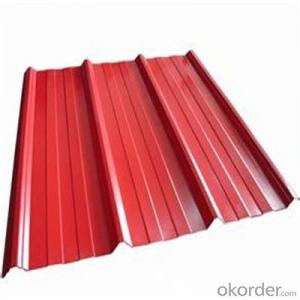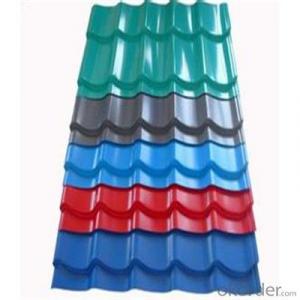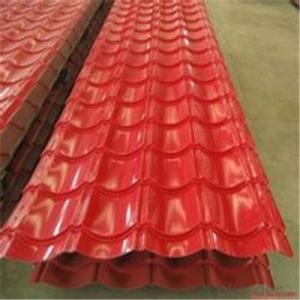Zinc Galvanized Corrugated Steel Iron Zinc Roof Sheet
- Loading Port:
- Tianjin
- Payment Terms:
- TT OR LC
- Min Order Qty:
- 100 m.t.
- Supply Capability:
- 1000345 m.t./month
OKorder Service Pledge
OKorder Financial Service
You Might Also Like
Item specifice
Description of Corrugated Iron Sheet:
Minimum yield strength of 550 MPa ensures required strength for roofing application
Accurate thickness, width and length gives a perfect fit for any roof
Wider valley ensures higher water discharge in case of heavy rains
Specifications of Corrugated Iron Sheet:
1) Chemical Composition: 55% Aluminum, 43.4% Zinc, 1.6% Silicon
2) Substrate: Galvalume steel sheet & Pre-painted galvalume steel sheet
3) Standard: JIS3321/ASTM A792M
4) Thickness: 0.16mm-2.0mm, all available
5) Width: 600mm-1250mm, all available
Features of Corrugated Iron Sheet:
Raw material width 762mm, after corrugated width 665mm: 9 waves.
Raw material width 914mm ,after corrugated width 800mm:11 waves.
Raw material width 1000mm, after corrugated 890mm or 900mm :12 or 14 waves. as customer requirement
Images of Corrugated Iron Sheet:

FAQ:
1. What's the Delivery port?
The main ports are Qingdao and Tianjin, we also can deliver to other ports to meet your requirements
2. How long is the lead time?
Delivery time: 45 days after order confirmed.
3. What payment term do you accept?
Payment: T/T or L/C at sight.
- Q:What are the advantages of using galvanized steel sheets?
- There are several advantages of using galvanized steel sheets. Firstly, galvanized steel sheets have a protective zinc coating that helps prevent rust and corrosion, making them highly durable and long-lasting. Secondly, they are resistant to extreme weather conditions, including rain, snow, and sunlight, which makes them suitable for outdoor applications. Additionally, galvanized steel sheets are versatile and can be easily formed into different shapes and sizes, making them ideal for various construction and manufacturing projects. Lastly, galvanized steel sheets are cost-effective as they require minimal maintenance and repair, reducing overall expenses in the long run.
- Q:What is the average yield strength of steel sheets?
- The average yield strength of steel sheets varies depending on the specific grade and thickness of the steel. However, it typically ranges from 250 to 400 megapascals (MPa).
- Q:How do steel sheets compare to fiberglass sheets?
- Steel sheets and fiberglass sheets have distinct characteristics that make them suitable for different applications. Steel sheets are known for their high strength and durability. They are capable of withstanding heavy loads and have excellent resistance to impact and abrasion. Steel sheets also offer exceptional fire resistance, making them ideal for applications where fire safety is a concern. Furthermore, steel sheets are relatively low maintenance and can withstand harsh weather conditions, making them a popular choice for outdoor structures such as roofing and siding. On the other hand, fiberglass sheets are lightweight and have excellent corrosion resistance. They are typically made from woven glass fibers embedded in a resin matrix, which gives them high strength-to-weight ratio. Fiberglass sheets are also non-conductive, making them suitable for applications where electrical insulation is required. Additionally, fiberglass sheets are highly transparent to electromagnetic waves such as radio waves, making them commonly used in industries such as telecommunications. While steel sheets offer superior strength and are better suited for heavy-duty applications, fiberglass sheets excel in areas where weight, corrosion resistance, and electrical insulation are important factors. Ultimately, the choice between steel sheets and fiberglass sheets depends on the specific requirements of the application and the desired characteristics needed to fulfill those requirements.
- Q:How do you determine the quality of steel sheets?
- One way to determine the quality of steel sheets is by examining their composition and properties. This can be done through various tests such as chemical analysis, mechanical testing, and visual inspection. Additionally, factors like the manufacturing process, certifications, and standards met by the steel manufacturer can also provide insights into the quality of the steel sheets.
- Q:How do steel sheets perform in terms of air permeability?
- Steel sheets have a very low air permeability, meaning that they do not allow air to pass through easily.
- Q:How can the offset film affixed to the cold-rolled steel sheet be removed?
- Hand cream can also be achieved to remove the effect of self-adhesive, hand cream contains a lot of water (generally more than 70%), water contains a certain amount of surfactant. Surfactant has good wetting, permeating and dissolving ability. It can quickly penetrate between the adhesive and the surface of the object, so as to achieve the goal of cleaning. You can also find some similar products, such as creams, facial cleanser and detergent.
- Q:What are the different sheet metal welding techniques for steel sheets?
- Steel sheets can be joined using various sheet metal welding techniques. The most commonly used methods are as follows: 1. MIG welding, also known as Gas Metal Arc Welding (GMAW), involves the use of a continuous wire electrode to create an arc and join the steel sheets. This technique is versatile and efficient, suitable for both thin and thick sheets. 2. TIG welding, or Gas Tungsten Arc Welding (GTAW), utilizes a non-consumable tungsten electrode to create an arc and join the steel sheets. It produces high-quality welds with excellent control, making it ideal for thin or delicate sheet metal. 3. Resistance Spot Welding (RSW) involves applying pressure and passing a high electrical current through the steel sheets using two electrodes. This causes the sheets to fuse together swiftly and cost-effectively. It is commonly used in the automotive and manufacturing industries. 4. Laser Welding employs a high-energy laser beam to melt and join the steel sheets. The technique offers precise control, high welding speeds, and minimal heat input, making it suitable for thin and highly reflective materials. 5. Electron Beam Welding (EBW) utilizes a focused beam of high-velocity electrons to create a weld. It offers deep penetration and is often used for thick steel sheets or applications requiring high-quality welds. 6. Plasma Arc Welding (PAW) is similar to TIG welding but utilizes a plasma arc to create a weld. This technique provides higher welding speeds and can be used for both thick and thin steel sheets. The choice of welding technique depends on various factors such as the thickness of the steel sheets, desired weld quality, production volume, and available equipment. Each method has its own advantages and limitations.
- Q:Can steel sheets be used in agricultural applications?
- Yes, steel sheets can be used in agricultural applications. They are commonly used for building structures like barns, sheds, and storage buildings due to their durability, strength, and resistance to harsh weather conditions. Steel sheets can also be used for fencing, roofing, and as a lining material for troughs and silos.
- Q:How do steel sheets perform in electrical resistance?
- Steel sheets have high electrical resistance, meaning they are not good conductors of electricity.
- Q:What are the different sheet metal joining techniques for steel sheets?
- Steel sheets can be joined using various techniques. Welding is commonly used, where the edges of the sheets are melted and fused together using heat and pressure. Different welding techniques like arc, spot, or laser welding can be used depending on the requirements. Riveting is another method, involving the use of metal fasteners called rivets. Holes are drilled in the sheets, and the rivets are inserted and deformed to secure the joint. This technique is suitable for structural applications due to its strength and durability. Bolting involves using bolts and nuts to connect the sheets. Holes are drilled, and bolts are inserted through them, with nuts tightened on the other side. Bolting allows for easy disassembly and reassembly, making it suitable for applications requiring frequent maintenance or repairs. Adhesive bonding is a technique where a strong glue is used to bond the sheets. The adhesive is applied between the surfaces, and pressure is applied for proper bonding. This method provides a clean and aesthetically pleasing joint without the need for drilling holes or using fasteners. Clinching is a cost-effective and quick method for joining steel sheets. It involves deforming the sheets using a punch and die, creating a mechanical interlock. This technique does not require additional materials and is suitable for various applications. The choice of joining technique depends on factors such as the specific application, required strength, durability, cost, and ease of assembly. Each technique has its own advantages and limitations.
1. Manufacturer Overview |
|
|---|---|
| Location | |
| Year Established | |
| Annual Output Value | |
| Main Markets | |
| Company Certifications | |
2. Manufacturer Certificates |
|
|---|---|
| a) Certification Name | |
| Range | |
| Reference | |
| Validity Period | |
3. Manufacturer Capability |
|
|---|---|
| a)Trade Capacity | |
| Nearest Port | |
| Export Percentage | |
| No.of Employees in Trade Department | |
| Language Spoken: | |
| b)Factory Information | |
| Factory Size: | |
| No. of Production Lines | |
| Contract Manufacturing | |
| Product Price Range | |
Send your message to us
Zinc Galvanized Corrugated Steel Iron Zinc Roof Sheet
- Loading Port:
- Tianjin
- Payment Terms:
- TT OR LC
- Min Order Qty:
- 100 m.t.
- Supply Capability:
- 1000345 m.t./month
OKorder Service Pledge
OKorder Financial Service
Similar products
New products
Hot products
Related keywords






























